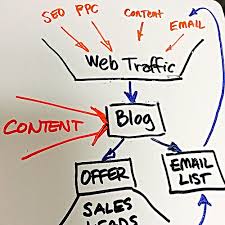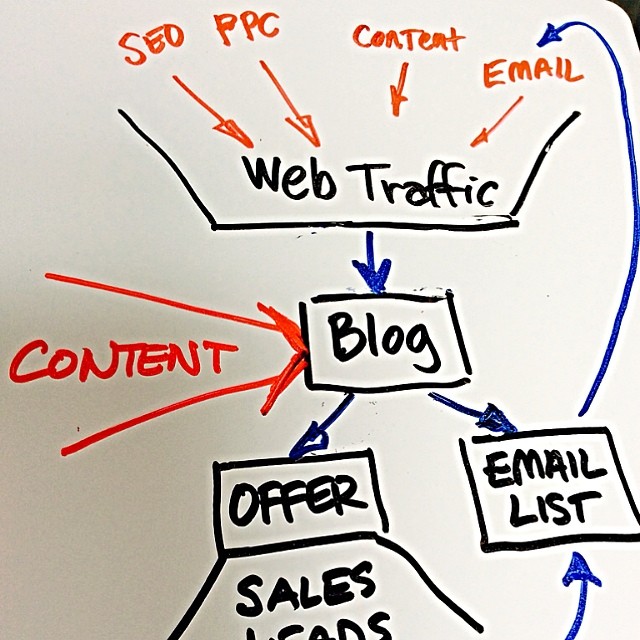
by Fronetics | Mar 7, 2016 | Blog, Content Marketing, Marketing, Social Media

Your content stinks. Here’s why.
Twenty-seven million pieces of content are shared every day — and most of it is crap. To attract readers to your content, you must stand out, and I mean really stand out, among the masses. That’s no easy feat.
You may be spending an enormous amount of time and money as part of a content marketing effort, but, if no one is reading what you’re producing, you’re definitely not achieving your ROI. Consider the following points, and ask yourself if any could be negatively impacting your readership.
Here are the top 10 reasons no one is reading your content.
10. You don’t have a strategy.
Only 11% of companies without a documented content marketing strategy find their efforts to be successful, compared to 60% of companies with a strategy in place. And that number rises to 86% when the company designates someone to lead the strategy. Having a clear vision for your content and a plan for executing that vision is crucial to earning an audience.
9. Your content isn’t search-engine optimized.
Seventy-seven percent of today’s buyers use Google to research information about products. Search engine optimization (SEO) means writing copy for your digital assets so they will be prioritized by Google in web queries related to your business or products. Three of four people will click on the top five search results. So the further you move from those top five results, the less likely someone is to find, much less read, your content. If your content isn’t SEO-friendly, readers may not even have the chance to see what you’re writing because it is so far down in their search results.
8. You are using the wrong channels.
If a tree falls in the woods and nobody is around to hear it, did the tree fall after all? Stop publishing in the empty woods. Who is the target audience for your content, and where are they active? Evaluate your audience (or lack thereof) in each of the channels where you publish, and see if something is amiss. This will vary greatly by business. You can access personalized information on your followers’ social media habits through analytic programs like Google Analytics and sites like Tweriod.
Also to consider: on lightning-fast platforms like Twitter, a miscalculation of timing could be to blame. (See The Best Time to Post on Social Media.)
7. You’re not publishing often enough.
Inconsistent content is one of the primary reasons readers become disengaged with a particular publisher. Even publishing one more blog post a week can significantly boost your readership. Try a little experiment for a few months by playing with the number of times per week you publish — say, three times per week one month, four times the next, and five the next. You’ll find the sweet spot where you get the most engagement but can also handle the production schedule.
The next reasons have to do with the substance of the content itself.
6. You’re publishing a sales pitch instead of content.
Imagine you’re looking to buy a car. Researching different options online, Site A, run by Dealership A, offers expert opinions about various makes and models, while Site B talks about how Dealership B offers top-notch customer service and a no-nonsense negotiation policy. You’d probably never come across Site B in the first place because the content is irrelevant (and trite… and annoying), whereas Site A has exactly what you’re looking for.
Content marketing is your opportunity to provide valuable, expert information to people who are seeking it out. Associating your brand with that sort of expertise attracts customers — not to mention, helps them find you via organic search in the first place. No one wants to read your sales pitch over and over again, and they won’t.
5. You are not telling the truth.
I am talking about two different definitions of truth here.
For one, are you being honest? Today’s consumers can smell b.s. from a mile away, largely because the Internet forgets nothing and forgives nothing. The prevalence of user-review sites and platforms like social media means customers will always have an outlet to share their experiences, both good and bad. If your business does not provide what you promise, people will be upset and take to these forums to complain about it. Trust and transparency are two key assets in earning (and keeping) readership.
Secondly, are you being true to who you are as a business? A recent Harvard Business Review article defines successful marketers as mission-focused, not consumer-focused. Don’t produce content based on what you think your customers want to hear. The beauty of content marketing is that when you put your business mission out into the universe through content, people who are seeking that information find you. In other words, build it, and they will come.
4. You’re not offering anything of value.
DigitalTonto says, “The first step towards engagement is creating value beyond the basic transaction of payment for a product or service.” This is the essence of content marketing: a related offer of value in the form of expertise, entertainment, etc. For example, L’Oreal Paris provides free makeup tutorials on its YouTube channel, Destination Beauty, and, Apple offers free classes, product demonstrations, and tech support from the Genius Bar for product users.
The question to ask is, what is your value to your customers? Can you offer expert advice on a particular topic through a blog? Is there something about your products or your people that would make for entertaining or informative videos? Do you have access to top-of-their-field specialists that could lead a webinar series? Find whatever it is that is unique to your company, and leverage that in your content marketing to attract readers.
Because there is so much content out there, today’s consumers can afford to be partial to publishers who provide information in a way that is pleasing to them. They also have shorter attention spans than goldfish. That means things like format, length, accessibility, and voice can majorly impact whether people read your content or not. Also, be mindful that different platforms should offer different experiences based on reader expectations (e.g., Instagram isn’t the place for lots of text).
2. You’re not heeding performance analytics.
The one certain constant in marketing is that things will always change. What works for you one year will certainly be irrelevant the next. Content marketing won’t allow you to rest on your laurels, either. You should stay on top of your analytics to monitor what kind of content is successful in the present moment, and you should tweak how you’re doing things as people, technology, and events change. Keep testing new ideas to see how they are received, and get rid of old standbys that no longer pull their weight.
1. Your content is bad.
While this seems obvious, it’s worth repeating. If the quality of your content is bad, no one will read it, regardless of what value it offers. The same goes for if you find yourself saying, “it works,” or “it’s fine!” If there are 27 million options, who would choose “fine?”
Do an honest evaluation of your content, or have a neutral outside party do so for you. Is it original, substantial, and well-written? Make sure that your content is edited, and that it is free from grammatical errors, spelling mistakes, and awkward phrasing. And remember that you get what you pay for. Professional writers can be expensive, but there’s a reason for that — theirs is a specialized craft, and very few people can do it well. If you want people to read your content, you should make sure that it’s worth reading.
Related articles:

by Fronetics | Mar 1, 2016 | Blog, Content Marketing, Marketing, Strategy
 A new digital marketing program helped one firm reinvent itself after traditional methods proved ineffective.
A new digital marketing program helped one firm reinvent itself after traditional methods proved ineffective.
A prominent marketing firm was experiencing an all-too-familiar predicament: They had a great product that, for some reason, was not selling. They had been following their traditional marketing regimen; however, something about the purchasing landscape seemed to have shifted, and in a way that rendered their methods ineffective.
Then, a new content marketing program changed everything in just a few months. For the better.
The firm’s business was real estate marketing, and their great product, a community of new homes in a highly desirable location. Real estate, like so many other sectors, has experienced a major shift in buyer behavior in just the last two decades, with the majority of research being conducted online. The firm realized that a digital marketing strategy, unlike traditional print ads, could better reach a wider audience of potential homebuyers.
In less than 90 days after implementing the new content marketing program, sales increased by nearly 40%. Within the year, social reach grew by 325%, web traffic by 250%, and sales by 300%.
Download this case study to learn how the firm achieved such remarkable results.

Related articles:

by Fronetics | Feb 24, 2016 | Blog, Content Marketing, Marketing, Strategy

Putting together digital marketing pieces in a way that fully meets regulatory requirements can grow your business exponentially.
There is a misconception that companies within a regulated industry are denied the benefit of digital marketing. These businesses often hide behind their regulations, simply because it is easier than working with them to create new avenues into the digital realm of marketing and company branding.
Is your marketing antiquated and stuck in the past? Could you be using regulations as an excuse to avoid change and stepping into the digital age? Are you really restricted from having an effective social media presence?
The facts say that you are not.
Regulated industries, such as those in the financial management realm, can be creating a very personal connection and presence with their customers, and therefore developing a competitive advantage. But, they must be willing to take the initiative to change how things are accomplished, to re-organize, and to create a cooperative strategy within their organization. Your mission, should you choose to accept it, is to tackle content marketing in a manner that fully upholds your regulatory standards.
It not only can be done, but the companies who successfully adjust can grow their businesses exponentially. In fact, other companies within your industry are probably already proving this to be true. A recent study indicated that that 77% of respondents from companies across industries planned to increase their digital marketing budgets in the coming year.
So, how does a business in a regulated industry — with restrictions on things like publishing, advertising, and even how interviews can be conducted — overcome these challenges and become a content marketing machine? How do you deal with the fact that every piece of content must be reviewed by an attorney or an outside compliance agency? How do you promote your business when there are even restrictions on customer testimonials?
First, marketing in today’s digital environment will require an overhaul of your strategic planning (aka, how you do things, and perhaps how you have always done things) and the release of any fear you have of digital marketing.
Creating an environment conducive to digital marketing
Here are a few tips to support this change:
- You must create a management environment where the swift development of rich content can thrive. In regulated industries, this probably means you need fast and effective access to an attorney, who can read and approve new content for public consumption within a couple of hours.
- You need to create a smooth, reciprocal interaction across these departments, with a focus on a more efficient operation and mutual support of the approval process.
- You need to invest financially in a solid strategic plan for your digital marketing. It takes money to make money, so to speak. Consider teaming up with a firm of talented individuals from outside your industry, who specialize in how to create digital content customized to your target demographic. This team should have the capability to analyze content performance metrics and to guide your digital presence to achieve optimal results. Their services should provide you a customized content plan, increase your customer engagement level, and develop a digital presence for your company that meets regulation standards for your industry.
- Your content writers and management team needs to be well-versed on the latest data and statistics, as well as your overall marketing initiatives, so they can produce content based on the latest facts and figures that will attract new customers. Essentially, they need to know what your new customers want and have the data available that will garner their attention.
Once you have paved the way, your company can begin to benefit from the creation of a blog, eBooks, and other digital presentations.
So how do you make it happen? How do you begin to access these modern marketing techniques in a regulated industry?
- First, your leadership team must be on board, ready to embrace change and to learn to communicate in new ways. If this is not something you can see happening because mindsets are stuck in the 1990s (pre-social media age), then you should educate stakeholders on how social media can impact a business’s growth and success.
- Redevelop the marketing department and provide the resources necessary to stay compliant and obtain necessary legal approvals quickly and efficiently.
- Befriend the legal department. They should be part of your support team, not a challenge you must overcome. Remove old paradigms and replace them with creative solutions, like an interactive spreadsheet shared between marketing and compliance to speed up the social posting process. Make marketing and compliance part of the same team, one that works together to seek solutions, alternatives, and compromises.
- Give it time. This is a big step in the right direction to align long-term strategies to better reach a new set of consumers. But it does not happen overnight. Plant the digital marketing seeds today and reap a crop of new customers tomorrow.
If you are in a regulated industry, the time to embrace change and step into the realm of digital marketing is now. Those who learn to evolve, to think creatively to find solutions, and to face new demands as a team are the ones that will rise to the top of their industry and experience a competitive advantage that supports future success.
Related articles:

by Fronetics | Feb 22, 2016 | Blog, Content Marketing, Current Events, Marketing, Strategy
Content marketing grew one real estate marketing firm’s sales by 300% in less than a year.

Consumers are increasingly going online to conduct research before making a purchase. And that holds true for even the largest investments.
The National Association of Realtors reports that a whopping 94% of Millennials who recently purchased a home relied on websites in their search process. And that’s not just a generational phenomenon — the majority of Baby Boomers (84%) and 69 to 89 year olds (65%) did online research while seeking a new home as well.
Real estate marketers have an enormous opportunity to get their properties in front of more potential buyers through content marketing. With an inbound marketing strategy, customers who are looking for a property like yours will come to you through their own online research.
Take, for example, this case study about a prominent real estate marketing firm in one of the most competitive markets in the U.S. When traditional tactics weren’t bringing in the kind of business needed to sell 1,500 new-construction homes in a new planned community, the firm turned to a new content marketing program to increase web traffic and build brand awareness.
The results were almost immediate. The new digital and content marketing efforts drastically increased web traffic, conversions, and sales. In just 90 days, sales had increased by 37%, and in less than a year, a whopping 300%. At least one-fifth of buyers were sourced directly from the website.
Download this case study to learn more about how content marketing helped the real estate marketing firm drive traffic to their website and increase sales.


by Fronetics | Jan 18, 2016 | Blog, Content Marketing, Marketing, Strategy
Improve your content marketing strategy in 2016 by following these six tips.
We know that content marketing is a highly effective tool for companies of all shapes and sizes, be they B2C or B2B. (If you’re not using inbound marketing, here are five reasons why you should be.) But, considering this strategy takes considerable time, effort, and resources, are you getting the most out of your efforts?
Long gone are the days when a weekly blog and vague presence on social media will cut it — 2016 is calling for a diversified content marketing strategy that speaks to today’s sophisticated consumer base.
Here are 6 ways to improve your content marketing strategy in 2016:
1) Be mobile-friendly.
Google announced in May 2015 that the number of searches on mobile devices has now surpassed those conducted on desktops in the US. And we know that reality isn’t limited to personal Internet use. Evidence suggests B2B buyers are increasingly using mobile devices to do research, make inquiries, and purchase products. If your website isn’t mobile-friendly, your company is missing out the significant share of customers who demand mobile-optimized content. What’s more, Google now penalizes non-mobile sites in searches, meaning your website will fall further below the fold, as more companies cater to smartphone screens.
Here’s how to make your supply chain website mobile-friendly.
2) Diversify your content.
A blog for which you provide regular, original content is an excellent start . But, unfortunately in this day and age, it’s not enough. Offering content in different formats provides a richer experience for your leads, adds depth to your brand identity, and allows you to reach and connect with more consumers. There are a dizzying number of options out there, including podcasts, slideshares, videos, graphics, ebooks, and whitepapers, to name a few. Choose a couple that fit your brand best, and see where they take you. Which leads me to…
3) Do video.
Video is not just for funny cats and cover artists anymore — it’s the most popular form of content being consumed online. YouTube is the second largest search engine in the world, with more than one billion users conducting over 3 billion searches per month. What’s more, the number of videos uploaded to Facebook has increased by 94% over the last year, with more than 50% of Americans who use Facebook daily viewing at least one video per day. Some brands have capitalized on this trend. (See the Budweiser puppy commercial, viewed over 30 million times.) But there is a lot of potential there for businesses in all industries — a little creativity and some time and effort adding video to your content marketing suite could really pay off.
4) Tug at the heartstrings.
There’s a reason the Budweiser puppy video has enjoyed so much success: we love a feel-good story. An ad that evokes strong emotions makes us associate those feelings with the brand. Studies show that emotions play a leading role in B2B purchases, too, and your content marketing should leverage that idea by telling great stories and by promoting the value you offer. Content that tells a great story connects people to your brand on an emotional and intellectual level, helping earn their trust and loyalty. Similarly, by touting figures that illustrate the value your company offers its customers — like money saved, convenience, or top-of-the-line performance — you remind people what it is you can do for them. And there’s no better way to win hearts (and leads) than reminding them what they’ll get out of your relationship.
5) Focus on relationship marketing.
HubSpot identifies relationship marketing as the #1 game-changing marketing trend to tackle in 2016. While this term largely falls under the CRM umbrella, it can play an important role in your content marketing strategy as well. Providing existing customers with custom-tailored content and information shows that you understand their needs, and it makes communications infinitely more personal. You’re not just blasting out some mass communication that ignores the facts that you know about your client — for example, a mass email titled “Baby it’s cold outside!” to a client based in Florida. Modern technologies like geo-targeting and CRM software make personalizing content and communications much easier, but it will still take extra time and resources. That’s the (absolutely worth-it) cost of long-term, loyal customers earned through relationship marketing.
6) Seek professional help.
Even if you’re part of the 58% of companies that handles content in-house, a little help from the experts will only improve your results. Hiring an SEO-savvy copywriter, for instance, can impact your bottom line. Or working with a firm like Fronetics can help you develop and execute a content marketing strategy designed to grow brand awareness and to meet your specific business goals. Here are six other digital and content marketing tasks to outsource. A fresh perspective from outside your company may be just what your marketing efforts need to excel in 2016.
Related articles:
When it comes to marketing we work with our clients to create and execute strategies that drive success and elevate their brand position within the industry. Unlike other firms, we align marketing programs with business objectives and, through a data driven approach, are able to deliver results with a targeted ROI. Our team is comprised of strategists, marketing professionals, writers, designers, and experts in social media. Together we leverage our experience to increase brand awareness, position our clients as thought leaders, drive meaningful engagement with prospects and customers, and help businesses grow. Learn more about what we do.








